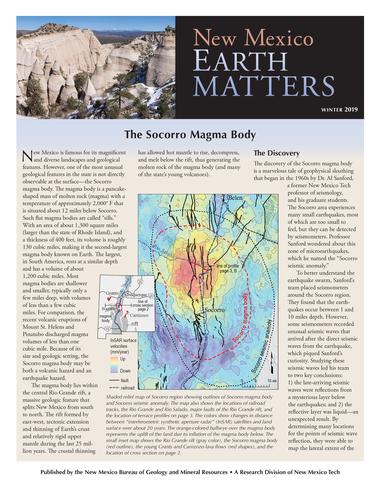
New Mexico Earth Matters — Back-issues

Vol. 19, No. 1, Winter 2019 1.93 MB
The Socorro Magma Body
— Gary Axen, Jolante van Wijk, Fred Phillips, Bruce Harrison, Brad Sion, Shuoyu Yao, and Dave Love
— Gary Axen, Jolante van Wijk, Fred Phillips, Bruce Harrison, Brad Sion, Shuoyu Yao, and Dave Love
New Mexico is famous for its magnificent and diverse landscapes and geological features. However, one of the most unusual geological features in the state is not directly observable at the surface—the Socorro magma body. The magma body is a pancakeshaped mass of molten rock (magma) with a temperature of approximately 2,000° F that is situated about 12 miles below Socorro. Such flat magma bodies are called “sills.” With an area of about 1,300 square miles (larger than the state of Rhode Island), and a thickness of 400 feet, its volume is roughly 130 cubic miles, making it the second-largest magma body known on Earth. The largest, in South America, rests at a similar depth and has a volume of about 1,200 cubic miles. Most magma bodies are shallower and smaller, typically only a few miles deep, with volumes of less than a few cubic miles. For comparison, the recent volcanic eruptions of Mount St. Helens and Pinatubo discharged magma volumes of less than one cubic mile. Because of its size and geologic setting, the Socorro magma body may be both a volcanic hazard and an earthquake hazard.


